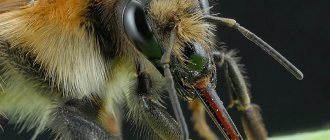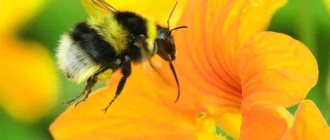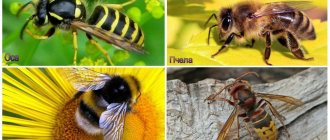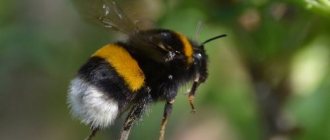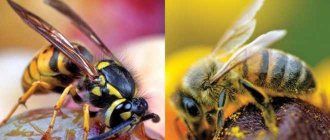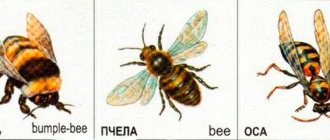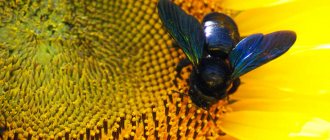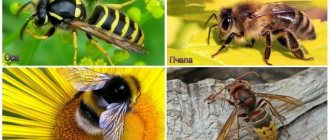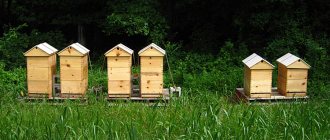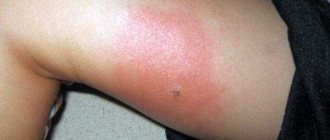- What do bumblebees eat?
The name of our today's hero - the bumblebee - came about thanks to the sounds that it usually makes during the flight, such buzzing, wheezing, from them came the ancient Russian word “chmel”, which over time transformed into the familiar modern “bumblebee”. By the way, the name of another well-known flyer was formed in a similar way -
mosquito But back to bumblebees, scientifically speaking, a bumblebee is an arthropod insect and belongs to the subclass of winged insects, the family of true bees, the genus of bumblebees proper (Bombus in Latin).
Description
Bumblebees belong to the class of arthropod winged insects and are a type of bee. The original name of the genus in Latin is “Bombus”. Creatures are widespread on Earth, living in all corners of the planet where there are suitable living conditions. Now zoologists know about 300 different varieties of insects, which belong to fifty subspecies.
The two most common types of bumblebees are Bombus terrestris and Bombus lapidarius. They live in most countries.
Back view of bumblebee
You can distinguish a bumblebee from other bees by its large size and rounded contours of its body. Thanks to the hairs on their body, they adapt well to cold climates and do not freeze. They are also considered warm-blooded insects. When moving quickly, their body begins to generate heat, and the internal temperature can reach forty degrees.
People have a stereotype that a bumblebee bite is very painful, and in general it is better to beware of insects.
Such fears arose due to the large size of the creature and powerful jaws. However, in fact, this type of bee is the most peaceful and harmless. Interesting fact : the sting of a bumblebee is smooth and does not have serrations, unlike a bee's.
If the latter retains it in the victim, then the bumblebee, having made a bite, can pull it back into the body and fly away. Bumblebees never attack first. They do not use their jaws as weapons, despite their power, and their only defense is their stinger. But the individual will use it if there is no other way out. Moreover, only females and insects that build a hive have it. Ordinary males do not have a sting and are almost completely defenseless. In nature, the bumblebee brings great benefits by pollinating a large number of flowers.
Sexual differences, reproduction
Sexual dimorphism is expressed implicitly. The sizes of females and males differ little. Features of female and male individuals relate to the appearance and structure of the body. Examples:
- the head of females is elongated, and that of males is round or triangular;
- males have a powerful mouthparts, while females have a rectangular upper lip and curved mandibles;
- in females, the abdomen ends in a smooth, multi-acting sting, and in males, instead of a stinger, the genitals are covered with a layer of chitin;
- On the hind legs of females there is a “basket”, that is, a place surrounded by hairs for collecting pollen grains.
Bumblebees reproduce through complete metamorphosis in nature. Insects go through 4 stages of development: egg, larva, pupa and adult. Fertilization of the uterus in the family occurs in the fall. Life cycle:
- Preparation for nesting - the fertilized queen flies out in the spring after wintering and looks for a suitable place.
- Set up the nest over a period of several weeks and place a wax bowl with nectar at the entrance.
- Laying elongated eggs of 8–16 pieces - before this, the queen creates a cushion of pollen and beebread, covered with wax, in the middle of the nest.
- The larvae emerge in 4–6 days - they stretch and break through the wax shell, and the female and her toilers constantly repair this layer.
- Pupation after 1.5–3 weeks - the larvae weave a cocoon, and the queen again creates an accumulation of pollen with beebread and lays another dozen eggs.
- Emerging from the cocoons after 10–19 days - the young animals gnaw through the shell; the empty cells are not disposed of in the family, but are left for storing honey.
The first offspring appears after 3–4 weeks. The emerging young become working bumblebees. They take on the responsibilities of the queen, while the female stops leaving the nest, but only lays eggs and helps feed the larvae. Insects do not use cells twice to rear brood, but build new devices each time.
Appearance and features
Yellow pollen on the black stripes of a bumblebee
A bumblebee has a massive body compared to other bees. Impressive dimensions are achieved due to developed pectoral muscles. They also serve as an additional source of heat along with the fluff. In cool weather, the insect begins to intensively contract its muscles, thereby increasing body temperature. This helps to warm up the body and go to pollinate flowers earlier than other types of bees.
On the sides of the body there are three pairs of limbs: two small legs in front and four large ones coming from the center. Bumblebees fly thanks to two wings located on the front of the body.
Bumblebees are black in color, with two yellow stripes on top: at the head and under the wings. There is also a white stripe in the sting area. The entire body is covered with small hairs, which determine the color pattern.
The head is quite small in relation to the body. At the top there are two long antennae planted next to the eyes. In front there is a powerful jaw, inside of which a long tongue is hidden.
Depending on the type, the insect can be of different sizes. Steppe bumblebees are the largest and can grow up to 3.5 cm in length. In common species, males reach up to 2.5 cm. Females are larger: their length reaches 2.9 cm. The body weight of males does not exceed 0.6 g , but for women it often exceeds 0.8 g.
Notes
- ↑
- Gornostaev G. N.
Insects of the USSR. - Moscow: Mysl, 1970. - 372 p. — (Reference books for geographers and travelers). - ↑ Key to insects of the Russian Far East. T. IV. Reticuloptera, Scorpioptera, Hymenoptera. Part 1 / under general ed. P. A. Lera. - St. Petersburg: Nauka, 1995. - P. 552-553. — 606 p. — 3150 copies. — ISBN 5-02-025944-6.
- ↑ Dave Goulson.
Bumblebees Behavior and Ecology. - Oxford, New York: Oxford University Press, 2003. - ISBN 0-19-852607-5. - ↑
- ↑
- BBC film “Life in a microcosm. Soaring up"
- Bumblebee // Small Encyclopedic Dictionary of Brockhaus and Efron: in 4 volumes - St. Petersburg, 1907-1909.
- ↑
- ↑
- (Williams, 1985a)
- ↑ A. P. Rasnitsyn and C. D. Michener (1991). "Miocene fossil bumble bees from the Soviet Far East with comments on the chronology and distribution of fossil bees (Hymenoptera: Apidae)". Annals of the Entomological Society of America 84(6)
: 583-589. - ↑ J. Zhang, B. Sun, and X. Zhang. 1994. Miocene insects and spiders from Shanwang, Shandong 1—298
- Riou B.
Descriptions de quelques insectes fossiles du Miocène supérieur de la Montagne d'Andance (Ardèche, France) // Travaux de l'École Pratique des Hautes Études, Biologie et Évolution des Insectes. - 1999. - Vol. 11/12. — P. 123-133. - Novák O. 1878. Fauna der Cyprisschiefer des Egerer Tertiärbeckens. Sitzungsberichte der Mathematisch-Naturwissenschaftlichen Classe der Kaiserlichen Akademie der Wissenschaften 76:71-96
- Cockerell TDA
Fossil Hymenoptera from Florissant, Colorado // Bulletin of the Museum of Comparative Zoology, Harvard College. - 1906. - Vol. 50(2). — P. 33-58. - Zhang JF
New fossil species of Apoidea (Insecta: Hymenoptera) // Acta Zootaxonomica Sinica. - 1990. - Vol. 15. - P. 83-91. - Rogenhofer H. 1867. Die Fossile Flora Von Kumi Auf Der Insel Euboea. Denkschriften der Kaiserlichen Akademie der Wissenschaften in Wien, Mathematisch-Naturwissenschaftlichen Classe 27:33
Where does the bumblebee live?
Habitat of bumblebees
Due to their good adaptation to environmental conditions, bumblebees live in almost all corners of the planet. Exceptions are places where there is very little vegetation, as well as in hot climates. At high temperatures, the insect begins to feel uncomfortable due to the fact that its body already generates a lot of heat during activities.
In some places the number of bumblebees is small. For example, the Arctic Circle is home to small populations of individual species adapted to cold climates and capable of pollinating local vegetation. In Greenland, Alaska and Chukotka they can only be found in alpine meadows. Small populations also occur in lands with a tropical climate.
Interesting fact : in some countries, gardeners specially breed garden bumblebees to increase productivity.
Most species of bumblebees live in Russia, Europe, Asia and America. They enjoy the local climate and abundant vegetation. Not so long ago, insects were specially brought to Australia, to the state of Tasmania. There they are used to increase the yield of clover, and bumblebees cope with their task with five points. And their peacefulness simplifies the process of using them.
Interesting: Spiders
